2000 YAMAHA XV1600A ABS
[x] Cancel search: ABSPage 12 of 95
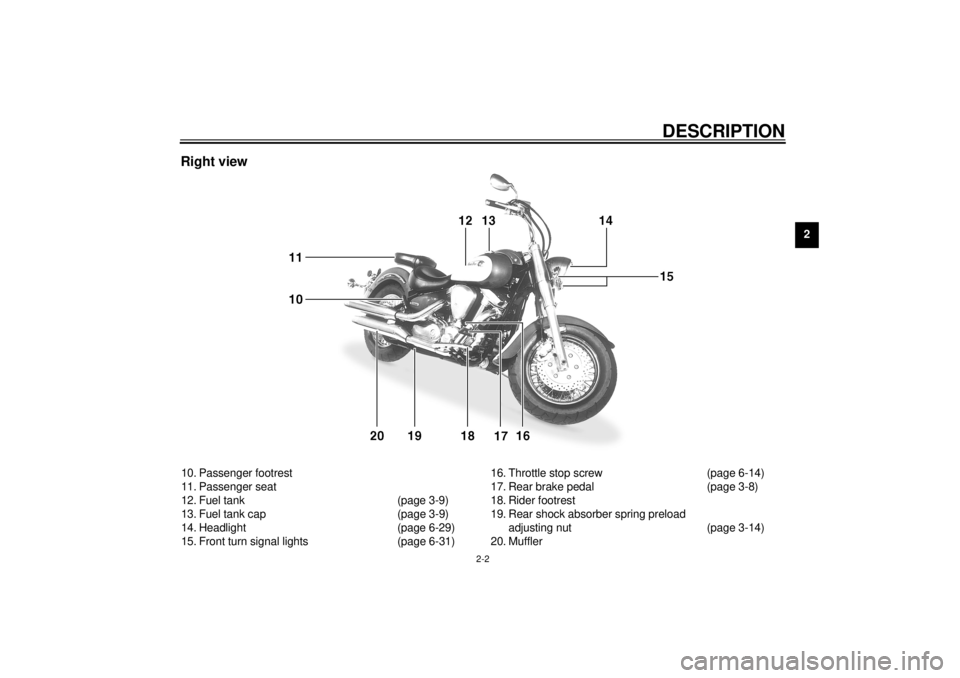
DESCRIPTION
2-2
2
Right view10. Passenger footrest
11. Passenger seat
12. Fuel tank (page 3-9)
13. Fuel tank cap (page 3-9)
14. Headlight (page 6-29)
15. Front turn signal lights (page 6-31)16. Throttle stop screw (page 6-14)
17. Rear brake pedal (page 3-8)
18. Rider footrest
19. Rear shock absorber spring preload
adjusting nut (page 3-14)
20. Muffler
E_5ja_Description.fm Page 2 Saturday, October 16, 1999 10:10 AM
Page 14 of 95
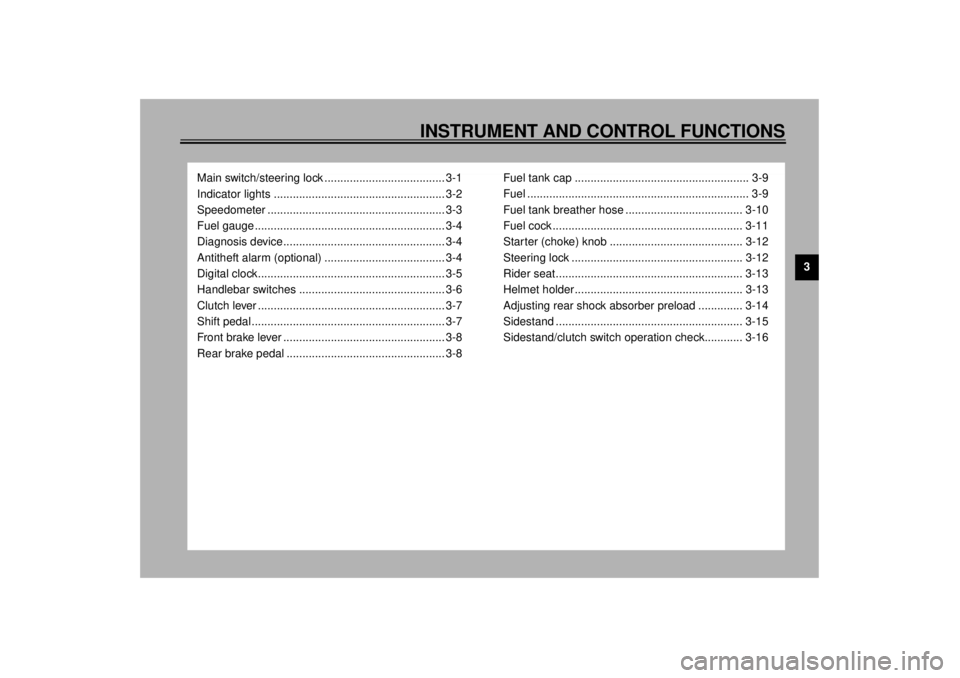
3
INSTRUMENT AND CONTROL FUNCTIONS
Main switch/steering lock ...................................... 3-1
Indicator lights ...................................................... 3-2
Speedometer ........................................................ 3-3
Fuel gauge ............................................................ 3-4
Diagnosis device................................................... 3-4
Antitheft alarm (optional) ...................................... 3-4
Digital clock........................................................... 3-5
Handlebar switches .............................................. 3-6
Clutch lever ........................................................... 3-7
Shift pedal ............................................................. 3-7
Front brake lever ................................................... 3-8
Rear brake pedal .................................................. 3-8Fuel tank cap ....................................................... 3-9
Fuel ...................................................................... 3-9
Fuel tank breather hose ..................................... 3-10
Fuel cock ............................................................ 3-11
Starter (choke) knob .......................................... 3-12
Steering lock ...................................................... 3-12
Rider seat........................................................... 3-13
Helmet holder..................................................... 3-13
Adjusting rear shock absorber preload .............. 3-14
Sidestand ........................................................... 3-15
Sidestand/clutch switch operation check............ 3-16
E_5ja_FunctionsTOC.fm Page 1 Saturday, October 16, 1999 10:10 AM
Page 28 of 95
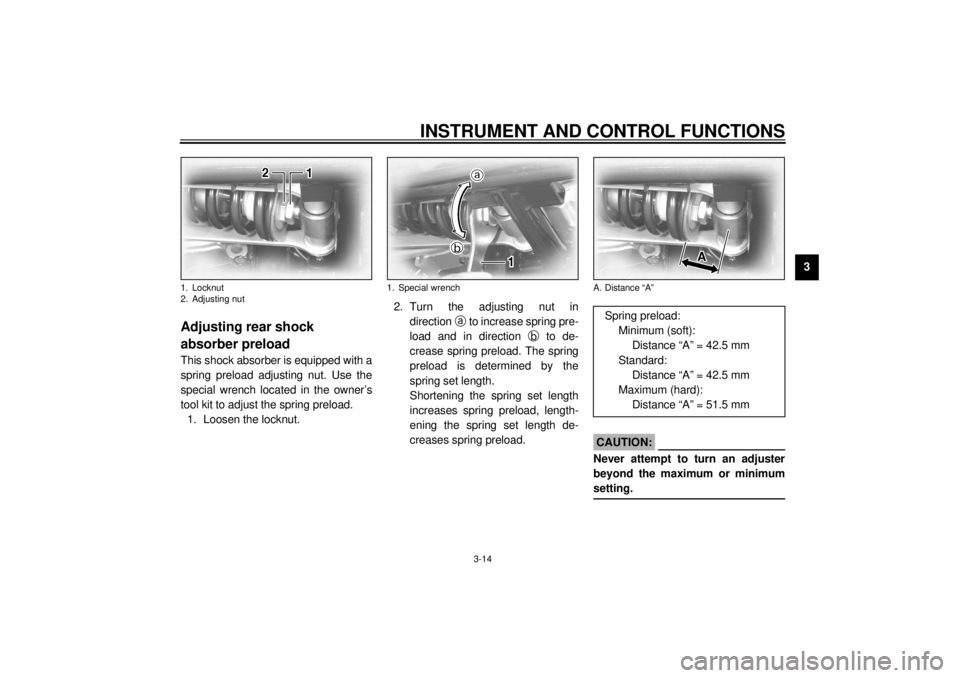
INSTRUMENT AND CONTROL FUNCTIONS
3-14
3
EAU01694
Adjusting rear shock
absorber preloadThis shock absorber is equipped with a
spring preload adjusting nut. Use the
special wrench located in the owner’s
tool kit to adjust the spring preload.
1. Loosen the locknut.2. Turn the adjusting nut in
direction
a to increase spring pre-
load and in direction
b to de-
crease spring preload. The spring
preload is determined by the
spring set length.
Shortening the spring set length
increases spring preload, length-
ening the spring set length de-
creases spring preload.
EC000015
CAUTION:@ Never attempt to turn an adjuster
beyond the maximum or minimum
setting. @
1. Locknut
2. Adjusting nut
1. Special wrench
A. Distance “A”Spring preload:
Minimum (soft):
Distance “A” = 42.5 mm
Standard:
Distance “A” = 42.5 mm
Maximum (hard):
Distance “A” = 51.5 mm
E_5ja_Functions.fm Page 14 Saturday, October 16, 1999 10:10 AM
Page 29 of 95
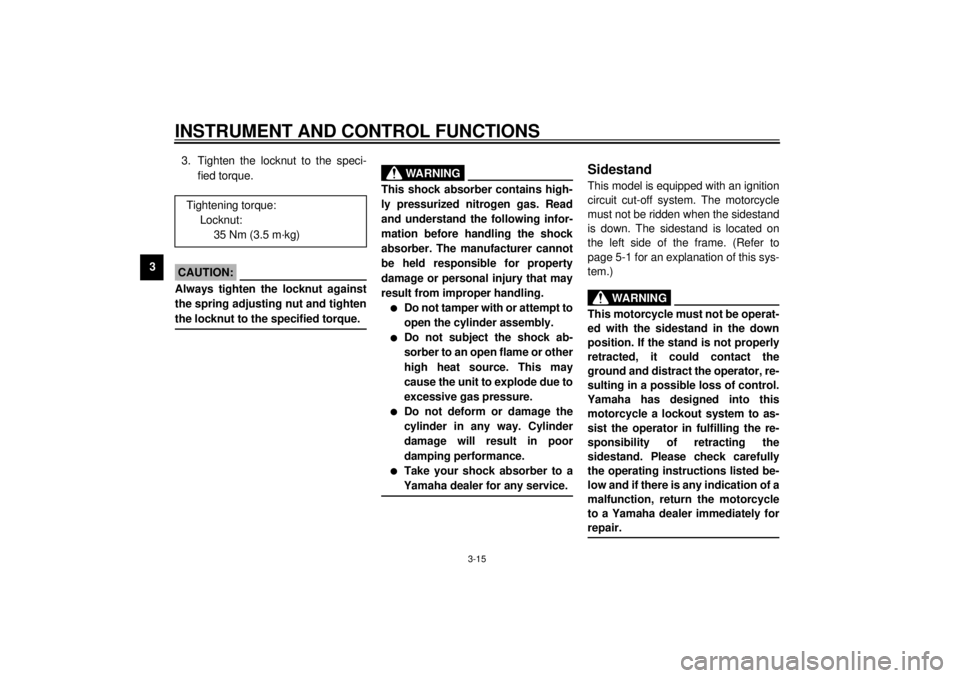
INSTRUMENT AND CONTROL FUNCTIONS
3-15
33. Tighten the locknut to the speci-
fied torque.
EC000018
CAUTION:@ Always tighten the locknut against
the spring adjusting nut and tighten
the locknut to the specified torque. @
EAU00315
WARNING
@ This shock absorber contains high-
ly pressurized nitrogen gas. Read
and understand the following infor-
mation before handling the shock
absorber. The manufacturer cannot
be held responsible for property
damage or personal injury that may
result from improper handling.l
Do not tamper with or attempt to
open the cylinder assembly.
l
Do not subject the shock ab-
sorber to an open flame or other
high heat source. This may
cause the unit to explode due to
excessive gas pressure.
l
Do not deform or damage the
cylinder in any way. Cylinder
damage will result in poor
damping performance.
l
Take your shock absorber to a
Yamaha dealer for any service.
@
EAU00330
SidestandThis model is equipped with an ignition
circuit cut-off system. The motorcycle
must not be ridden when the sidestand
is down. The sidestand is located on
the left side of the frame. (Refer to
page 5-1 for an explanation of this sys-
tem.)
EW000044
WARNING
@ This motorcycle must not be operat-
ed with the sidestand in the down
position. If the stand is not properly
retracted, it could contact the
ground and distract the operator, re-
sulting in a possible loss of control.
Yamaha has designed into this
motorcycle a lockout system to as-
sist the operator in fulfilling the re-
sponsibility of retracting the
sidestand. Please check carefully
the operating instructions listed be-
low and if there is any indication of a
malfunction, return the motorcycle
to a Yamaha dealer immediately for
repair. @
Tightening torque:
Locknut:
35 Nm (3.5 m·kg)
E_5ja_Functions.fm Page 15 Saturday, October 16, 1999 10:10 AM
Page 48 of 95

PERIODIC MAINTENANCE AND MINOR REPAIR
6-4
6
11
*Wheel bearings• Check bearing for looseness or damage.
• Replace if necessary. ÖÖ
12*Swingarm• Check swingarm pivoting point for play.
• Correct if necessary.
• Lubricate with molybdenum disulfide grease every 24,000 km or
24 months (whichever comes first).ÖÖ
13*Drive belt• Check belt tension.
• Adjust if necessary. Make sure that the rear wheel is properly
aligned.ÖEvery 4,000 km
14*Steering bearings• Check bearing play and steering for roughness.
• Correct accordingly.
• Lubricate with lithium soap base grease every 24,000 km
or 24 months (whichever comes first).ÖÖ
15*Chassis fasteners• Make sure that all nuts, bolts and screws are properly tightened.
• Tighten if necessary.ÖÖ
16 Sidestand• Check operation.
• Lubricate and repair if necessary.ÖÖ
17*Sidestand switch• Check operation.
• Replace if necessary.ÖÖÖ
18*Front fork• Check operation and for oil leakage.
• Correct accordingly.ÖÖ
19*Rear shock absorber
assembly• Check operation and shock absorber for oil leakage.
• Replace shock absorber assembly if necessary. ÖÖ
20*Rear suspension relay
arm and connecting arm
pivoting points• Check operation.
• Lubricate with molybdenum disulfide grease every 24,000 km or
24 months (whichever comes first).ÖÖ
21*Carburetor• Check engine idling speed and starter operation.
• Adjust if necessary.ÖÖÖ NO. ITEM CHECKS AND MAINTENANCE JOBSINITIAL
(1,000 km)EVERY
6,000 km
or
6 months
(whichever
comes first)12,000 km
or
12 months
(whichever
comes first)
E_5ja_Periodic.fm Page 4 Saturday, October 16, 1999 10:12 AM
Page 60 of 95
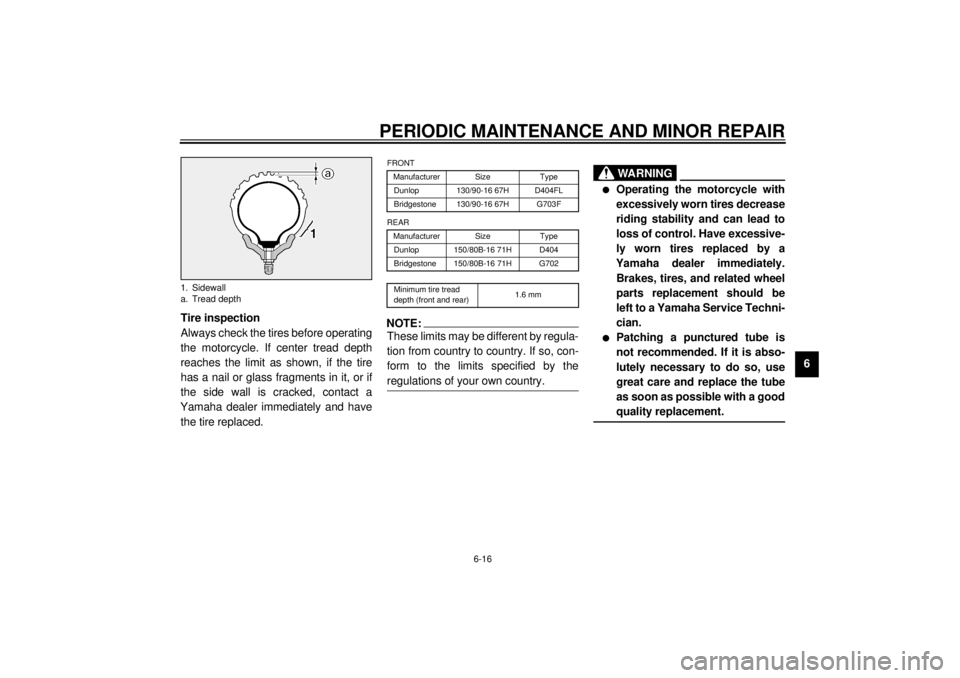
PERIODIC MAINTENANCE AND MINOR REPAIR
6-16
6 Tire inspection
Always check the tires before operating
the motorcycle. If center tread depth
reaches the limit as shown, if the tire
has a nail or glass fragments in it, or if
the side wall is cracked, contact a
Yamaha dealer immediately and have
the tire replaced.
CE-10E
CE-11ENOTE:@ These limits may be different by regula-
tion from country to country. If so, con-
form to the limits specified by the
regulations of your own country. @
EAU00681
WARNING
@ l
Operating the motorcycle with
excessively worn tires decrease
riding stability and can lead to
loss of control. Have excessive-
ly worn tires replaced by a
Yamaha dealer immediately.
Brakes, tires, and related wheel
parts replacement should be
left to a Yamaha Service Techni-
cian.
l
Patching a punctured tube is
not recommended. If it is abso-
lutely necessary to do so, use
great care and replace the tube
as soon as possible with a good
quality replacement.
@
1. Sidewall
a. Tread depth
FRONT
Manufacturer Size Type
Dunlop 130/90-16 67H D404FL
Bridgestone 130/90-16 67H G703F
REAR
Manufacturer Size Type
Dunlop 150/80B-16 71H D404
Bridgestone 150/80B-16 71H G702
Minimum tire tread
depth (front and rear)1.6 mm
E_5ja_Periodic.fm Page 16 Saturday, October 16, 1999 10:12 AM
Page 81 of 95

MOTORCYCLE CARE AND STORAGE
7-3
7After riding in the rain, near the sea or
on salt-sprayed roadsSince sea salt or salt sprayed on the
roads in the winter are extremely corro-
sive in combination with water, carry
out the following steps after each ride
in the rain, near the sea or on salt-
sprayed roads. (Salt sprayed in the
winter may remain on the roads well
into spring.)
1. Clean your motorcycle with cold
water and soap after the engine
has cooled down.
ECA00012
CAUTION:@ Do not use warm water since it in-
creases the corrosive action of the
salt. @2. Be sure to apply a corrosion pro-
tection spray on all (even chrome-
and nickel-plated) metal surfaces
to prevent corrosion.After cleaning
1. Dry the motorcycle with a chamois
or an absorbing cloth.
2. Use a chrome polish to shine
chrome, aluminum and stainless-
steel parts, including the exhaust
system. (Even the thermally in-
duced discoloring of stainless-
steel exhaust systems can be re-
moved through polishing.)
3. To prevent corrosion, it is recom-
mended to apply a corrosion pro-
tection spray on all (even chrome-
and nickel-plated) metal surfaces.
4. Use spray oil as a universal clean-
er to remove any remaining dirt.
5. Touch up minor paint damage
caused by stones, etc.
6. Wax all painted surfaces.
7. Let the motorcycle dry completely
before storing it or covering it.
EWA00001
WARNING
@ Make sure that there is no oil or wax
on the brakes and tires. If neces-
sary, clean the brake discs and lin-
ings with a regular brake disc
cleaner or acetone, and wash the
tires with warm water and mild soap.
Then, carefully test the motorcycle
for its braking performance and cor-
nering behavior. @
E_5ja_Cleaning.fm Page 3 Monday, October 18, 1999 5:04 PM
Page 87 of 95

SPECIFICATIONS
8-3
8
Maximum load* 196 kg
Air pressure (cold tire)
Up to 90 kg load*
Front 250 kPa (2.50 kg/cm
2, 2.50 bar)
Rear 250 kPa (2.50 kg/cm2, 2.50 bar)
90 kg load ~
maximum load*
Front 250 kPa (2.50 kg/cm2, 2.50 bar)
Rear 280 kPa (2.80 kg/cm2, 2.80 bar)
* Load is total weight of cargo, rider, passenger and accessories.
Wheels
Front
Type Spoke
Size 16 ´ MT 3.00
Rear
Type Spoke
Size 16 ´ MT 3.50
Brakes
Front
Type Dual disc brake
Operation Right hand operation
Fluid DOT 4Rear
Type Single disc brake
Operation Right foot operation
Fluid DOT 4
Suspension
Front
Ty p e Te l e s c o p i c f o r k
Rear
Type Swingarm (link suspension)
Shock absorber
Front Coil spring/oil damper
Rear Coil spring/gas-oil damper
Wheel travel
Front 140 mm
Rear 110 mm
Electrical
Ignition system T.C.I. (digital)
Charging system
Type A.C. magneto
Standard output 14 V, 21 A @ 5,000 r/min
Battery
Type YTX20L-BS
Voltage, capacity 12 V, 18 AH
E_5ja_Spec.fm Page 3 Saturday, October 16, 1999 10:18 AM